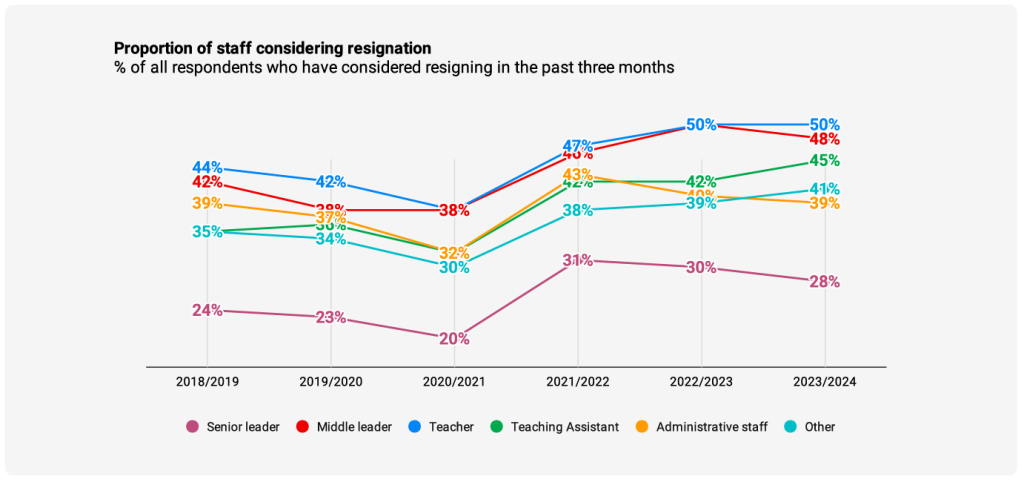3 July, 2024
Addressing teacher retention challenges: what are the initiatives?
Discover key insights from Edurio’s report on staff retention in academies. Learn about the challenges and potential solutions for retaining teachers and teaching assistants.
This blog is written by Scott Owen. Scott is a former teacher who spent 6 years working in secondary and special needs schools in the 1990s before leaving the profession. Subsequently, he has worked in education recruitment, most recently with Supporting Education Group, where he helped MAT leaders adopt new approaches to finding teaching and support staff.
Edurio’s new report, Staff Retention in Academies, presents a stark reality for school and MAT leaders. The report’s key findings reveal significant and potentially systemic challenges in retaining teachers and teaching assistants.
The report’s findings are particularly concerning for younger teachers and teaching assistants. They are disproportionately more likely to leave their roles or the education sector, underscoring the severity of the issue.

Overall, 50% of teachers and 45% of teaching assistants had considered resigning in the last three months, compared to 28% of senior leaders and 39% of administrative staff. While 48% of middle leaders had also considered resigning, 60% of those would likely stay in the profession. Only 54% of teachers and 44% of teaching assistants planned to remain in education if they resigned.

When broken down by age group, staff aged 25 to 35 were the most likely to consider resignation constantly, often, or sometimes. Looking at the teacher cohort, the tendency to consider resignation is highest for those with between 2 and 5 years of experience. When looking at the main reasons, people have considered resignation, overwhelming workload, and feeling undervalued are the top reasons by some distance.
Does this sound familiar?
The figures are disappointing, but are they unexpected? Young teachers and teaching assistants who have invested less in their careers, have less experience managing their workload and can switch jobs with less friction choose to look elsewhere.
If it were any other industry sector, these figures would be less concerning (in retail and hospitality, two sectors disproportionately reliant on younger staff, these retention figures would be considered miraculous). However, education remains societally essential, even if the teaching profession is not held in the same esteem as medicine or is as well remunerated as financial services.
Combining the figures in the Edurio report with the missed teacher recruitment target (50% for secondary and 4% for primary teachers) for 2023/24, we paint a picture of a profession approaching crisis point.
What can be done?
With too few people entering the teaching profession and too many leaving, the arithmetic is straightforward. Either increase one side of the equation or decrease the other. But what if the answer was to do both?
Too few young people enter the profession, and the money spent on promoting the ITT route is not helping. Conversely, when people take the ITT route into teaching, they are too quickly ground down by workload and feel undervalued. The reality of teaching is not how it seems in the adverts.
One way of squaring this circle is to increase the number and variety of young people experiencing work in schools and provide effective pathways to quickly get those with the aptitude and attitude to succeed as teachers into the workforce.
Alternative pathways
The existing graduate Apprenticeship and next year’s non-graduate route into teaching provide forward-thinking schools and trusts with a way to use the apprenticeship levy to expand the number of young people experiencing work in school.
These flexible approaches allow aspiring teachers to earn while they learn. These programs can provide practical, hands-on experience in the classroom while they complete their training.
Working with apprenticeship providers means schools can quickly adopt an apprenticeship programme and learn what is required to create a successful environment to convert apprentices into full-time, long-serving staff members.
Initiatives such as United Learning’s Future Teacher Programme offer structured pathways for graduates to enter the teaching profession. The programme converts the supply budget into something more progressive.
Case Study: Swindon & Wiltshire Teaching School Hub
Graduates gain first-hand experience working in a school by doing a year of cover work. After a period of extended hire via an agency, the school directly employs successful future teachers. After a year, they are placed on a SCITT programme within the academy they have been working in.
The program lets graduates hone their classroom management and curriculum delivery skills before training. The MAT makes a substantial commitment to Future Teachers, but anecdotal feedback from those involved suggests it is worth it. Many graduates take on positions of responsibility more quickly and stick with the trust for longer than their non-Future Teacher Programme counterparts.
Making schools youth-friendly
There is much schools can do to make themselves more attractive to younger employees.
Much has been written about the need for flexible work, career development opportunities, and supportive work culture, particularly within the secondary sector. However, looking at the statistics for new entrants to secondary teaching, it is hard to see the delivery model continuing unchanged indefinitely.
In the short term, schools need to foster an inclusive environment where young teachers and teaching assistants feel valued and heard while changing working patterns, reducing workload, and managing individuals more compassionately if they want them to remain in post.
None of this is easy, but schools and MATs must change to avoid the alternative of a hollowing out of an ageing teaching profession, rising class sizes, and AI used to mitigate falling teacher numbers rather than reduce the workload burdens of teachers and teaching assistants.
